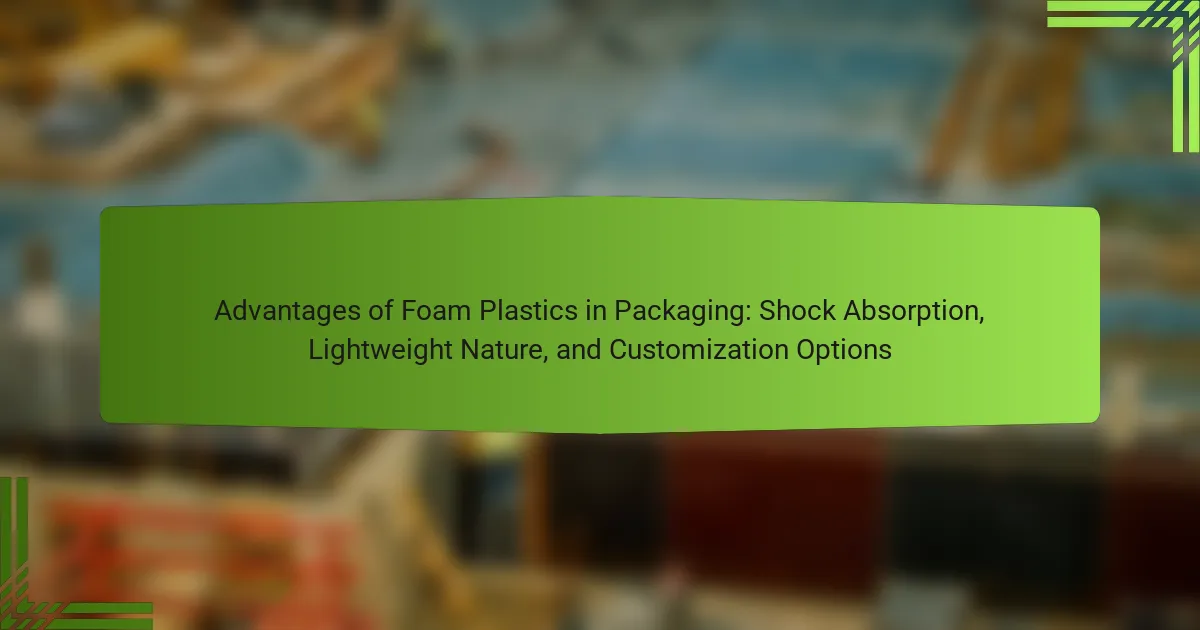Foam plastics are a key material in packaging that offer several advantages, including shock absorption, lightweight properties, and customization options. Their excellent shock absorption capabilities protect fragile items during transit, while their lightweight nature contributes to reduced shipping costs and improved efficiency. Foam plastics can be easily tailored to accommodate various product shapes and sizes, optimizing space in packaging. Additionally, these materials are resistant to moisture and chemicals, providing enhanced protection for packaged goods. These features make foam plastics a preferred choice for numerous industries seeking effective packaging solutions.

What are the Advantages of Foam Plastics in Packaging?
Foam plastics in packaging offer several advantages. They provide excellent shock absorption, protecting fragile items during transit. Their lightweight nature reduces shipping costs and enhances efficiency. Foam plastics can be easily customized to fit various shapes and sizes of products. This adaptability allows for better use of space in packaging. Additionally, foam materials are often resistant to moisture and chemicals, adding an extra layer of protection. These characteristics make foam plastics a preferred choice for many industries.
How does Shock Absorption work in Foam Plastics?
Shock absorption in foam plastics occurs through the material’s ability to deform under pressure. When an impact occurs, the foam compresses, which dissipates energy. This compression reduces the force transmitted to the object being protected. The cellular structure of foam plastics allows for this deformation. The air-filled cells collapse and then recover, returning to their original shape. This unique structure enables the foam to absorb and distribute shock effectively. Studies show that certain foam types can absorb over 90% of impact energy. This makes foam plastics ideal for protective packaging applications.
What materials contribute to the shock-absorbing properties of foam plastics?
Polymeric materials such as polyurethane and polystyrene contribute to the shock-absorbing properties of foam plastics. These materials have a cellular structure that allows them to compress and deform under pressure. This deformation absorbs energy, reducing the impact force transmitted to the packaged items. The closed-cell structure of polystyrene foam provides additional resistance to moisture, enhancing durability. Polyurethane foam is known for its flexibility and resilience, making it suitable for various applications. Studies show that these materials can significantly reduce shock during transport. For instance, polyurethane foams can absorb up to 60% of impact energy, demonstrating their effectiveness in cushioning.
How effective is foam plastic in protecting fragile items during transport?
Foam plastic is highly effective in protecting fragile items during transport. It provides excellent shock absorption, which minimizes the risk of damage from impacts. The lightweight nature of foam plastic reduces shipping costs while still offering robust protection. Additionally, foam can be customized to fit specific shapes and sizes of fragile items, enhancing its protective capabilities. Studies have shown that foam packaging reduces breakage rates significantly compared to traditional packing materials. For example, a study by the Packaging Research Institute found that items packed with foam plastic experienced 50% less damage during transit than those packed with cardboard. This demonstrates that foam plastic is a reliable choice for safeguarding fragile goods.
Why is the Lightweight Nature of Foam Plastics Beneficial?
The lightweight nature of foam plastics is beneficial because it reduces shipping costs and enhances product protection. Lighter materials decrease transportation expenses, which can significantly lower overall logistics costs. Foam plastics also provide excellent cushioning, protecting fragile items from damage during transit. This combination of lightweight and protective properties makes foam plastics ideal for various packaging applications. Additionally, their lightweight nature allows for easier handling and processing in manufacturing environments. Studies show that using lightweight materials can lead to a reduction in carbon emissions associated with transportation. Thus, the lightweight nature of foam plastics contributes to both economic and environmental benefits.
What impact does the lightweight nature have on shipping costs?
The lightweight nature of packaging materials significantly reduces shipping costs. Lighter packages require less fuel for transportation. This results in lower freight charges for businesses. Additionally, companies can ship more products at once due to weight limits. For example, shipping costs can decrease by up to 30% with lightweight materials. This cost efficiency benefits manufacturers and retailers alike. Overall, using lightweight packaging optimizes logistics and enhances profitability.
How does the weight of foam plastics compare to traditional packaging materials?
Foam plastics are significantly lighter than traditional packaging materials. For example, expanded polystyrene (EPS) foam weighs about 1.5 to 2.0 pounds per cubic foot. In contrast, materials like cardboard or wood can weigh 20 to 40 pounds per cubic foot. This vast difference in weight allows foam plastics to reduce shipping costs and improve handling efficiency. Additionally, the lightweight nature of foam plastics contributes to lower carbon emissions during transportation. Studies show that using lighter materials can decrease fuel consumption by up to 20%. Thus, foam plastics provide a substantial advantage in weight compared to traditional packaging options.
What Customization Options are Available with Foam Plastics?
Foam plastics offer various customization options to meet specific packaging needs. These options include different densities, which affect cushioning properties. Custom shapes can be molded to fit unique products securely. Color choices allow for branding and aesthetic preferences. Surface textures can be modified for grip or visual appeal. Additionally, foam plastics can be laminated with other materials for enhanced performance. Custom sizes ensure optimal use of space and material efficiency. These customization options enhance the protective qualities of foam plastics in packaging applications.
How can foam plastics be tailored to specific product dimensions?
Foam plastics can be tailored to specific product dimensions through precise molding techniques. These techniques include custom molds that match the exact shape and size of the product. The foam can be produced in various densities to accommodate different weight requirements. Additionally, cutting and shaping processes can be employed after production for further adjustments. CNC machining is often used for accuracy in these alterations. This customization allows for optimal protection and support during shipping and handling. Studies show that tailored foam packaging reduces damage rates by up to 30%.
What are the benefits of custom shapes and designs in packaging?
Custom shapes and designs in packaging enhance product visibility and appeal. They allow brands to stand out on shelves. Unique packaging can attract more consumers, increasing sales. Custom designs can improve product protection during transit. They can be tailored to fit specific product shapes, reducing movement and damage. This customization can also optimize material usage, minimizing waste. Studies show that eye-catching packaging can boost brand recognition by up to 80%. Tailored designs can create a memorable unboxing experience, fostering customer loyalty.
How do Foam Plastics Contribute to Sustainability in Packaging?
Foam plastics contribute to sustainability in packaging by being lightweight and energy-efficient. Their reduced weight lowers transportation costs and emissions. This leads to a smaller carbon footprint during distribution. Additionally, foam plastics can be made from recycled materials. This recycling process minimizes waste and promotes a circular economy. Many foam plastics are also recyclable after use. This further reduces landfill contributions. Moreover, their durability extends the lifespan of packaging, decreasing the need for frequent replacements. Overall, these factors enhance the sustainability profile of foam plastics in packaging.
What recyclable options are available for foam plastics?
Foam plastics can be recycled through several methods. Common options include mechanical recycling, where foam is shredded and reprocessed into new products. Chemical recycling breaks down foam into its original monomers for reuse. Some facilities also offer drop-off programs specifically for foam packaging materials. Expanded polystyrene (EPS) is often accepted at designated recycling centers. According to the EPS Industry Alliance, approximately 30% of EPS can be recycled. These methods help reduce waste and promote sustainability in packaging.
How does using foam plastics reduce overall waste in packaging?
Using foam plastics reduces overall waste in packaging by minimizing material use and enhancing product protection. Foam plastics are lightweight, which decreases shipping costs and energy consumption. Their shock-absorbing properties prevent damage to products during transit, reducing the need for additional packaging materials. According to a study by the Plastics Industry Association, lightweight packaging can lead to a 20% reduction in overall packaging waste. Additionally, foam plastics can be molded to fit specific products, ensuring efficient use of space and materials. This customization leads to less excess packaging, further decreasing waste. Overall, foam plastics contribute to a more sustainable packaging solution.
What Industries Most Frequently Utilize Foam Plastics in Packaging?
The industries that most frequently utilize foam plastics in packaging include electronics, food and beverage, automotive, and medical sectors. In the electronics industry, foam plastics protect delicate components during shipping. The food and beverage industry uses foam for insulation and cushioning of products. Automotive manufacturers rely on foam for packaging parts and components securely. Medical products benefit from foam packaging to ensure safe transport of sensitive items. These industries prioritize foam plastics for their lightweight nature and effective shock absorption properties.
How do different industries leverage the advantages of foam plastics?
Different industries leverage the advantages of foam plastics primarily for their shock absorption and lightweight nature. In the packaging industry, foam plastics protect fragile items during shipping. They reduce the risk of damage, which is crucial for electronics and glass products. The automotive industry utilizes foam plastics for sound insulation and weight reduction. This contributes to improved fuel efficiency. The construction sector employs foam plastics for insulation, enhancing energy efficiency in buildings. Additionally, the medical field uses foam plastics for cushioning in equipment and packaging for sensitive medical devices. These applications demonstrate the versatility and benefits of foam plastics across various sectors.
What specific applications of foam plastics are prevalent in each industry?
Foam plastics have diverse applications across various industries. In the packaging industry, they are primarily used for protective cushioning. This helps to absorb shocks during transportation. In the automotive industry, foam plastics serve as sound insulation and energy absorption materials. They enhance passenger comfort and safety. In the construction sector, foam plastics are utilized for insulation. This improves energy efficiency in buildings. In the electronics industry, they provide anti-static packaging solutions. This protects sensitive components from damage. In the medical field, foam plastics are used for cushioning in medical devices. They ensure patient comfort and safety. These applications highlight the versatility and effectiveness of foam plastics across multiple sectors.
What are the Best Practices for Implementing Foam Plastics in Packaging?
Best practices for implementing foam plastics in packaging include selecting the appropriate type of foam for specific applications. Considerations should include density, thickness, and resilience. Evaluate the product being packaged to determine the necessary level of protection. Use custom foam inserts to ensure a snug fit around products. This prevents movement during transit and enhances shock absorption. Utilize environmentally friendly foam options when possible to reduce environmental impact. Ensure compliance with relevant regulations and standards for packaging materials. Test packaging prototypes to assess performance before full-scale production. Regularly review and update packaging strategies based on feedback and new developments in foam technology.
How can companies optimize their use of foam plastics for maximum efficiency?
Companies can optimize their use of foam plastics for maximum efficiency by implementing advanced manufacturing techniques. Techniques like injection molding and extrusion can enhance the precision of foam production. This leads to reduced waste and improved material utilization. Companies should also conduct regular assessments of their foam usage. Monitoring performance metrics can identify areas for improvement. Additionally, employing innovative designs can maximize the protective qualities of foam while minimizing material use. Research shows that optimized foam designs can reduce packaging weight by up to 30%. Lastly, investing in employee training on best practices can further streamline operations and ensure efficient use of foam plastics.
What common challenges should be addressed when using foam plastics in packaging?
Common challenges when using foam plastics in packaging include environmental concerns, cost-effectiveness, and performance issues. Environmental concerns arise due to the non-biodegradable nature of many foam plastics. This leads to increased waste and pollution. Cost-effectiveness can be a challenge as some foam materials may be more expensive than alternatives. Performance issues include the potential for degradation over time, which can affect protective qualities. Additionally, foam plastics may not provide adequate protection for all types of products, leading to damage during transit. These challenges require careful consideration in packaging design and material selection.
Foam plastics are a versatile packaging solution known for their shock absorption, lightweight nature, and customization options. This article explores the advantages of foam plastics, highlighting their effectiveness in protecting fragile items during transport, reducing shipping costs, and enhancing sustainability. Key attributes such as the materials that contribute to shock absorption, the benefits of customization, and the industries that frequently utilize foam plastics are discussed. Additionally, best practices for implementing foam plastics in packaging are outlined, addressing common challenges and strategies for optimization.


